Bottled Water Vs. Tap Water: Rethink What You Drink
Updated: May 03, 2017
Chemicals, contaminants, pollution, price: new reasons to rethink what you drink and beware of bottled water.
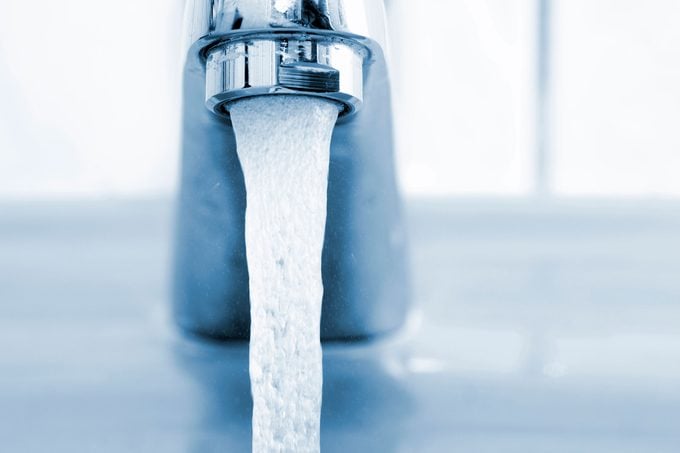 Remember the drinking fountain, that once ubiquitous, and free, source of H2O? It seems quaint now. Instead, bottled water is everywhere, in offices, airplanes, stores, homes and restaurants across the country. We consumed over eight billion gallons of the stuff in 2006, a 10 percent increase from 2005. It’s refreshing, calorie-free, convenient to carry around, tastier than some tap water and a heck of a lot healthier than sugary sodas. But more and more, people are questioning whether the water, and the package it comes in, is safe, or at least safer than tap water—and if the convenience is worth the environmental impact.
Remember the drinking fountain, that once ubiquitous, and free, source of H2O? It seems quaint now. Instead, bottled water is everywhere, in offices, airplanes, stores, homes and restaurants across the country. We consumed over eight billion gallons of the stuff in 2006, a 10 percent increase from 2005. It’s refreshing, calorie-free, convenient to carry around, tastier than some tap water and a heck of a lot healthier than sugary sodas. But more and more, people are questioning whether the water, and the package it comes in, is safe, or at least safer than tap water—and if the convenience is worth the environmental impact.
What’s in That Bottle?
Evocative names and labels depicting pastoral scenes have convinced us that the liquid is the purest drink around. “But no one should think that bottled water is better regulated, better protected or safer than tap,” says Eric Goldstein, co-director of the urban program at the Natural Resources Defense Council (NRDC), a nonprofit organization devoted to protecting health and the environment.
Yes, some bottled water comes from sparkling springs and other pristine sources. But more than 25 percent of it comes from a municipal supply. The water is treated, purified and sold to us, often at a thousandfold increase in price. Most people are surprised to learn that they’re drinking glorified tap water, but bottlers aren’t required to list the source on the label.
This year Aquafina will begin stating on labels that its H2O comes from public water sources. And Nestlé Pure Life bottles will indicate whether the water comes from public, private or deep well sources. Dasani acknowledges on its website, but not on the label itself, that it draws from local water.
Labels can be misleading at best, deceptive at worst. In one notorious case, water coming from a well located near a hazardous waste site was sold to many bottlers. At least one of these companies labeled its product “spring water.” In another case, H2O sold as “pure glacier water” came from a public water system in Alaska.
Lisa Ledwidge, 38, of Minneapolis, stopped drinking bottled water a couple of years ago, partly because she found out that many brands come from a municipal supply. “You’re spending more per gallon than you would on gasoline for this thing that you can get out of the tap virtually for free,” she says. “I wondered, Why am I spending this money while complaining about how much gas costs? But you don’t ever hear anyone complain about the price of bottled water.” Ledwidge says she now drinks only filtered tap water.
Next: Is your bottled water clean? »
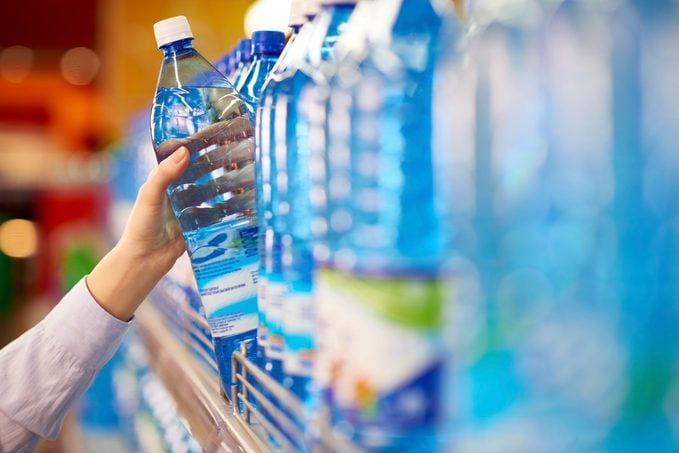 Is Your Bottled Water Clean?
Is Your Bottled Water Clean?
The controversy isn’t simply about tap vs. bottled water; most people drink both, knowing the importance of plenty of water. What they may not know is that some bottled water may not be as pure as they expect. In 1999 the NRDC tested more than 1,000 bottles of 103 brands of water. (This is the most recent major report on bottled water safety.) While noting that most bottled water is safe, the organization found that at least one sample of a third of the brands contained bacterial or chemical contaminants, including carcinogens, in levels exceeding state or industry standards. Since the report, no major regulatory changes have been made and bottlers haven’t drastically altered their procedures, so the risk is likely still there.
The NRDC found that samples of two brands were contaminated with phthalates, in one case exceeding Environmental Protection Agency (EPA) standards for tap water. These chemicals, used to make plastic softer, are found in cosmetics and fragrances, shower curtains, even baby toys, and are under increasing scrutiny. They’re endocrine disrupters, which means they block or mimic hormones, affecting the body’s normal functions. And the effects of exposure to the widespread chemicals may add up.
When exposed to high levels of phthalates during critical developmental periods, male fetuses can have malformed reproductive organs, including undescended testicles. Some experts link phthalates to low sperm counts.
Water bottles do not contain the chemical, which means the phthalates detected by the NRDC probably got into the water during processing at the bottling plant, or were present in the original water source (phthalates have been found in some tap water).
Bottled water is regulated for safety, but it’s a tricky thing. The EPA regulates tap water, while the FDA oversees bottled. Yet FDA oversight doesn’t apply to water packaged and sold within the same state, leaving some 60 to 70 percent of bottled water, including the contents of watercooler jugs, free of FDA regulation, according to the NRDC’s report. In this case, testing depends on the states, but the NRDC found that they often don’t have adequate resources to oversee bottled water, in some cases lacking even one full-time person for an entire state.
The FDA requires bottlers to regularly test for contaminants, but the agency considers bottled water a low-risk product, so plants may not be inspected every year. According to one FDA official, it’s the manufacturer’s responsibility to ensure that the product complies with laws and regulations. Some bottlers turn to NSF International, a trade group that conducts yearly unannounced inspections of plants, looking at the source of the water and the treatment process, and testing for contaminants. Other companies belong to the International Bottled Water Association (IBWA), which also performs annual unannounced tests to ensure the plant is up to FDA standards. IBWA has its own regulations, some of which are stricter than the FDA’s.
Bottlers don’t have to let consumers know if their product becomes contaminated, but sometimes they pull their products from stores. In fact, between 1990 and 2007, this happened about 100 times, says Peter Gleick of the Pacific Institute in Oakland, California. Among the reasons for recall: contamination with mold, benzene, coliform, microbes, even crickets.
Next: Are the bottles safe to drink from? »
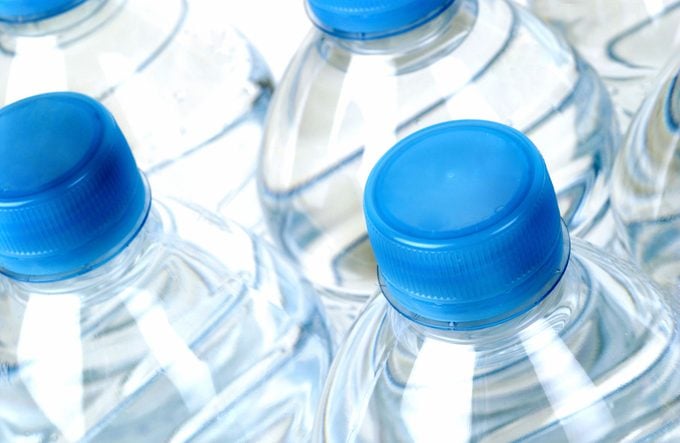 Are the Bottles Safe?
Are the Bottles Safe?
Most bottled water comes in polyethylene terephthalate bottles, indicated by a number 1, PET or PETE on the bottle’s bottom. (No, it’s not the same phthalate mentioned earlier.) The bottles are generally safe, says Ken Smith, PhD, immediate past chair of the American Chemical Society’s division of environmental chemistry. But scientists say when stored in hot or warm temperatures, the plastic may leach chemicals into the water.
Brenda Decker, 45, of Lake Stockholm, New Jersey, used to buy bottled water in bulk and store it in the crawl space under her house, where it was exposed to high temperatures. But a friend who owns a natural food store recently warned her that the plastic could leach chemicals into the water. So Decker has stopped buying bottled water and is going back to the tap. “It’s a process, but I’m willing to go with it to make sure my kid is healthy. That’s my biggest drive.”
High temperatures in your storage space aren’t the only potential risk; so are the other things you keep there. Experts advise against storing water in the garage, near gas fumes, pesticides and other chemicals that could, at the very least, affect the smell and taste of the H2O.
It’s not just where you store your water, but what you do with it as you carry it with you. Many people sip from a bottle that’s been sitting in a hot car, a potentially dangerous move. “Leaving bottled water out in the car changes the chemical equilibrium so that the materials from the plastic go into the water faster,” says Smith.
When 22-year-old Amy Dowley, a senior at Vassar College in Poughkeepsie, New York, heard about these risks, she was worried. “I never drank bottled water, because I knew the water from my tap was clean and healthy, but I used to fill used plastic soda or juice bottles with tap water to carry around,” she says. Now she uses a stainless steel Klean Kanteen portable container or fills a cup from the sink. “Any way we can cut back on plastic is a good thing.”
“Are there hazards associated with these chemicals?” asks James Kapin, a chemical safety consultant in San Diego. “Absolutely.” But as with many debates on chemicals, the exact health risks are unknown. “We very rarely get black-and-white answers for the health effects of long-term exposure. At some point, I hope, there will be a scientific consensus.”
In the meantime, experts have raised a warning flag about a few specific chemicals. Antimony is a potentially toxic material used in making PET. Last year, scientists in Germany found that the longer a bottle of water sits around (in a store, in your home), the more antimony it develops. High concentrations of antimony can cause nausea, vomiting and diarrhea. In the study, levels found were below those set as safe by the EPA, but it’s a topic that needs more research.
Last summer, a National Institutes of Health (NIH) committee agreed that bisphenol A (BPA), a chemical found in polycarbonate (used to make watercooler jugs, sport-water bottles and other hard plastics, but not PET), may cause neurological and behavioral problems in fetuses, babies and kids. A separate NIH-sponsored panel found that the risk was even greater, saying that adult exposure to BPA likely affects the brain, the female reproductive system and the immune system. The FDA has reviewed these reports and says it will keep monitoring the data to see if the agency needs to take regulatory action.
Next: What’s the impact on the planet? »
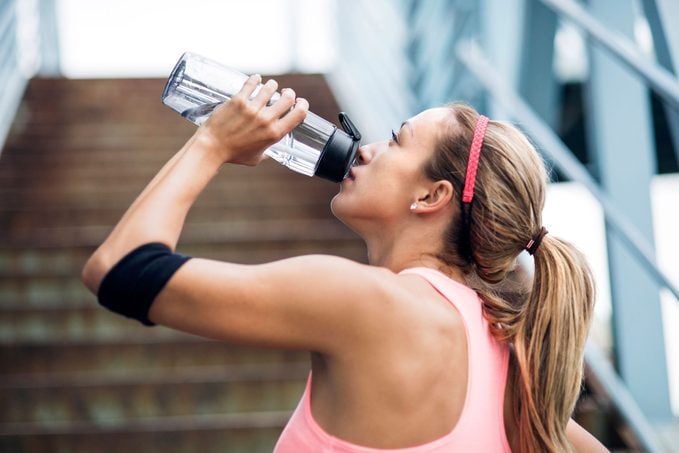 Bottled Water’s Impact on the Planet
Bottled Water’s Impact on the Planet
The potential health risks are important to understand, but bottled water also affects the health of the planet.
“Bottled water is an increasingly growing business, and with that comes a whole lot of environmental impact that can be avoided by a turn of the faucet,” says Jenny Powers of the NRDC. While we struggle to cut down on our consumption of fossil fuels, bottled water increases them. Virgin petroleum is used to make PET, and the more bottles we use, the more virgin petroleum will be needed to create new bottles. Fossil fuels are burned to fill the bottles and dis-tribute them. (Stephen Kay of IBWA points out that it’s not just bottled water, but juices, soda and other beverages packed in plastic that add to this waste.)
Some brands of water come from islands and countries thousands of miles away, and shipping bottles can cause carbon pollution to spill into the water and spew into the air.
Then there’s the waste of water itself, says Todd Jarvis, PhD, associate director of the Institute for Water and Watersheds at Oregon State University. According to his calculations, it takes about 72 billion gallons of water a year, worldwide, just to make the empty bottles.
Treating and filtering tap water for bottling creates even more waste. By some estimates, it takes about two liters of water to make every liter you see on store shelves. “Bottled water has a significant environmental burden,” says the NRDC’s Goldstein.
A big part of the appeal of bottled water is those convenient single-serving bottles. Yet fewer than 20 percent of them ever make it to a second life, according to estimates by the Container Recycling Institute. The rest are tossed onto beaches and roadsides and into landfills, where they could be around for a thousand years. Nestlé Waters, Dasani and other bottlers are trying to be greener, introducing lighter-weight bottles that use up to 30 percent less plastic.
It’s a good start, but more needs to be done—by them, and by us.
Bottled Water’s Environmental Toll
• The energy used each year making the bottles needed to meet the demand for bottled water in the United States is equivalent to more than 17 million barrels of oil. That’s enough to fuel over 1 million cars for a year.
• If water and soft drink bottlers had used 10% recycled materials in their plastic bottles in 2004, they would have saved the equivalent of 72 million gallons of gasoline. If they had used 25%, they would have saved enough energy to electrify more than 680,000 homes for a year.
• In 2003, the California Department of Conservation estimated that roughly three million water bottles are trashed every day in that state. At this rate, by 2013 the amount of unrecycled bottles will be enough to create a two-lane highway that stretches the state’s entire coast.
• In 2004 the recycling rate for all beverage containers was 33.5 percent. If it reached 80 percent, the reduction of greenhouse gas emissions would be the equivalent of removing 2.4 million cars from the road for a year.
• That bottle that takes just three minutes to drink can take up to a thousand years to biodegrade.
Sources: Earth Policy Institute, As You Sow, Container Recycling Institute.
Next: Which should you pick? »
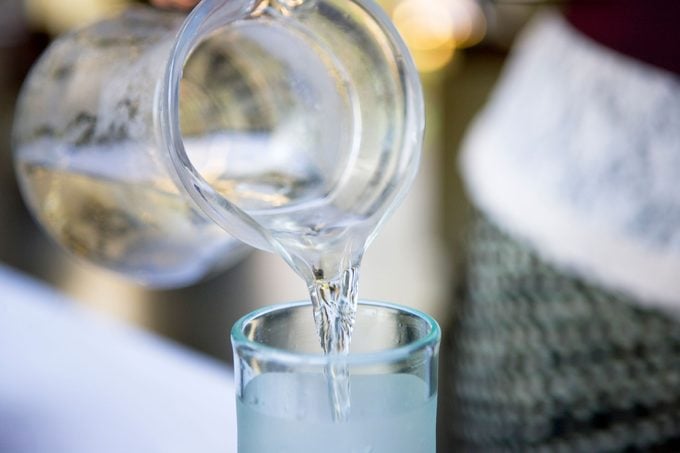 What Can You Do?
What Can You Do?
Worried about the toll your bottled water habit has on you or the earth? Take these steps.
• Try the tap again. First, check it out. If your water comes from a public source (rather than a well), you should get a water-quality or consumer-confidence report from the water company once a year. It’s also available at any time from the local water utility. Read the report carefully, making sure not only that your water has received a passing grade overall but also that contaminants haven’t exceeded the maximum allowable levels, even for a short while. If you have well water, get it tested every year. For more information, call the EPA’s toll-free Safe Drinking Water Hotline at 800-426-4791, or visit the website for the Campaign for Safe and Affordable Drinking Water.
• Get a canteen. Carry your plain or filtered tap water in a reusable stainless steel or lined drinking container, and clean it between uses. Some come with an easy-to-tote strap. We like the stainless steel versions from Klean Kanteen and New Wave Enviro, and the colorful bottles from SIGG.
• Think twice about the office watercooler. If it’s made of polycarbonate, it has the potential to leach BPA, a chemical that can cause neurological problems, among other things. And have you ever seen anyone actually clean the watercooler? Probably not.
• Shop smart. When you must have bottled, look for brands that have NSF certifica-tion or belong to IBWA. Check out the lists at nsf.org or bottledwater.org, or look at the bottle itself (the NSF logo appears on labels of tested brands). If the brand you’re looking for isn’t there, contact the bottler. Ask where the water is bottled and what exactly is in it.
• Keep it cool. Don’t drink from a bottle that’s been subjected to high temperatures (sitting in your car, for example), don’t store it anywhere it will be exposed to heat or chemicals, and don’t reuse plastic bottles.
• Go with glass. Choose glass containers (Eden Springs and Voss are two popular brands) over plastic whenever possible. When you’re done, recycle!
Do You Need a Filter?
The water that comes out of your faucet is probably safe. In general, toxins in drinking water don’t exceed EPA limits, but there are still legitimate concerns. From a funny taste to lead contamination from aging pipes, your tap water may have picked up some unsavory additions along the way.
What’s in your water? Certain areas of the country are subject to particular toxins, such as runoff from farms and by-products of industry, like arsenic, which can also occur naturally in the environment.
Have it tested. If you’re concerned, have your water tested by a lab that’s certified by the state; the EPA has an online listing of certification officers, or call your health department for recommendations.Choose a filter. Choices range from tabletop containers, such as a carafe with a carbon filter (Brita and PUR are popular brands), to devices that purify the water as it enters your home. In between are faucet-mounted, under-sink and reverse osmosis units. Look for one approved by NSF, Underwriters Laboratories or the Water Quality Association, and clean it as recommended by the manufacturer. Do it yourself. Some water is treated with chlorine to kill bacteria, but the taste turns people off. The fix? Pour water into a clear glass container and leave it uncovered in the refrigerator for 24 hours to let the chlorine dissipate into the air.
Fluoride Facts
Most bottled water doesn’t contain added fluoride (if it does, it will say so on the label). Kids are drinking more bottled water and less fluoridated tap, and some say that’s behind the recent rise in dental decay. While the cavity link hasn’t been confirmed, pediatric dentist Mary Hayes, DDS, says, “I tell parents that if they choose bottled water without fluoride, they’re losing an opportunity to protect their child’s teeth. We know fluoride has a great track record in diminishing the risk of decay.”
If your tap water is fortified, you probably don’t need fluoride in bottled. But if your family has well water without fluoride, drinks only bottled or uses a filter that removes fluoride (many do), ask your dentist about supplements for your child.